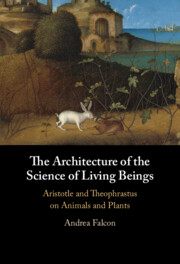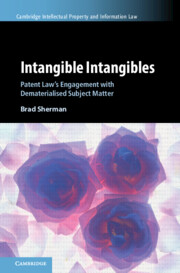150 results
Chapter 5 - Neuropsychiatric Perspectives on the Biology of Anxiety and Youth Climate Distress
- from Part I - Conceptual Foundations of Climate Distress in Young People
-
-
- Book:
- Climate Change and Youth Mental Health
- Print publication:
- 13 June 2024, pp 93-110
-
- Chapter
- Export citation
Chapter 6 - The Invention of Biology?
-
- Book:
- The Architecture of the Science of Living Beings
- Published online:
- 30 May 2024
- Print publication:
- 06 June 2024, pp 187-208
-
- Chapter
-
- You have access
- Open access
- HTML
- Export citation

The Architecture of the Science of Living Beings
- Aristotle and Theophrastus on Animals and Plants
-
- Published online:
- 30 May 2024
- Print publication:
- 06 June 2024
-
- Book
-
- You have access
- Open access
- Export citation

Intangible Intangibles
- Patent Law's Engagement with Dematerialised Subject Matter
-
- Published online:
- 25 April 2024
- Print publication:
- 09 May 2024
-
- Book
-
- You have access
- Open access
- Export citation
Impact of Aphis pomi-tending Formica rufa (Hymenoptera: Formicidae) on biological parameters of Hippodamia variegata (Coleoptera: Coccinellidae)
-
- Journal:
- Bulletin of Entomological Research / Volume 114 / Issue 2 / April 2024
- Published online by Cambridge University Press:
- 11 April 2024, pp. 293-301
-
- Article
- Export citation
Yuval Harari on Human Rights and Biology
-
- Article
-
- You have access
- Open access
- HTML
- Export citation
9 - Female Physiology in John Buridan’s Quaestiones de secretis mulierum
-
-
- Book:
- Interpreting Buridan
- Published online:
- 01 February 2024
- Print publication:
- 08 February 2024, pp 157-177
-
- Chapter
- Export citation
2 - Adult Dyslexia
- from Part I
-
- Book:
- Succeeding and Adult Dyslexia
- Published online:
- 11 January 2024
- Print publication:
- 01 February 2024, pp 25-58
-
- Chapter
- Export citation
Chapter 9 - The Minotaur (Hybrida minotaurus)
-
- Book:
- The Trojan Horse and Other Stories
- Published online:
- 09 November 2023
- Print publication:
- 11 January 2024, pp 209-242
-
- Chapter
- Export citation
Life table parameters and digestive physiology of Aulacophora lewisii Baly (Coleoptera: Chrysomelidae) on three Luffa acutangula (L.) Roxb. (Cucurbitaceae) cultivars
-
- Journal:
- Bulletin of Entomological Research / Volume 114 / Issue 1 / February 2024
- Published online by Cambridge University Press:
- 05 January 2024, pp. 134-148
-
- Article
- Export citation
Cultural history: an interdisciplinary approach
-
- Article
-
- You have access
- Open access
- HTML
- Export citation
8 - Some Concluding Thoughts
-
- Book:
- A Communitarian Theory of WTO Law
- Published online:
- 14 December 2023
- Print publication:
- 21 December 2023, pp 428-460
-
- Chapter
- Export citation
Introduction
-
- Book:
- Theistic Evolution
- Published online:
- 19 October 2023
- Print publication:
- 02 November 2023, pp 1-17
-
- Chapter
- Export citation
5 - Reframing the Social, Rethinking the Body, Confronting Biologism
- from Part One - Openings and Orientations
-
-
- Book:
- The Cambridge Handbook for the Anthropology of Gender and Sexuality
- Published online:
- 29 September 2023
- Print publication:
- 19 October 2023, pp 126-152
-
- Chapter
- Export citation
3 - London Calling, 1836–1842
-
- Book:
- Understanding Charles Darwin
- Published online:
- 31 August 2023
- Print publication:
- 14 September 2023, pp 51-66
-
- Chapter
- Export citation
5 - “[T]his view of life, with its several powers”
-
- Book:
- Understanding Charles Darwin
- Published online:
- 31 August 2023
- Print publication:
- 14 September 2023, pp 97-125
-
- Chapter
- Export citation
7 - The Struggle Is Real
-
- Book:
- Understanding Charles Darwin
- Published online:
- 31 August 2023
- Print publication:
- 14 September 2023, pp 147-169
-
- Chapter
- Export citation
Concluding Remarks
-
- Book:
- Understanding Charles Darwin
- Published online:
- 31 August 2023
- Print publication:
- 14 September 2023, pp 170-178
-
- Chapter
- Export citation
4 - Darwin–Wallaceism
-
- Book:
- Understanding Charles Darwin
- Published online:
- 31 August 2023
- Print publication:
- 14 September 2023, pp 67-96
-
- Chapter
- Export citation
2 - The Truth About Atolls
-
- Book:
- Understanding Charles Darwin
- Published online:
- 31 August 2023
- Print publication:
- 14 September 2023, pp 31-50
-
- Chapter
- Export citation



